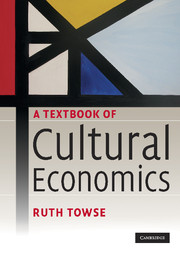Book contents
- Frontmatter
- Contents
- List of figures
- List of tables
- List of boxes
- List of abbreviations
- Preface
- Part I General issues in cultural economics
- Part II The ‘traditional’ economics of the arts and heritage
- Introduction
- 8 Economics of the performing arts
- 9 Economics of cultural heritage
- 10 Economic evaluation of cultural policy
- Part III Artists' labour markets and copyright
- Part IV The creative industries
- Part V Conclusion and exercises and problems
- References
- Index
8 - Economics of the performing arts
- Frontmatter
- Contents
- List of figures
- List of tables
- List of boxes
- List of abbreviations
- Preface
- Part I General issues in cultural economics
- Part II The ‘traditional’ economics of the arts and heritage
- Introduction
- 8 Economics of the performing arts
- 9 Economics of cultural heritage
- 10 Economic evaluation of cultural policy
- Part III Artists' labour markets and copyright
- Part IV The creative industries
- Part V Conclusion and exercises and problems
- References
- Index
Summary
The performing arts – live music, opera, dance, theatre – occupy a special place in cultural economics for two reasons: they are supported by public funding in many countries and therefore attract attention and controversy; and they were the subject of the economic analysis by Baumol and Bowen introduced in chapter 1.
In the terminology of the creative industries, the performing arts occupy a position at the central core (described in chapter 14). Their activities have been defined in the United Kingdom as including content origination, costume design and making, and lighting, along with live performance. Many of these items are protected by intellectual property law; although live performance is not always protected per se until it is recorded or broadcast, authors and performers have the right to authorise any reproduction.
Economic characteristics of the performing arts
The performing arts (both non-profit and for-profit) have some common economic characteristics. A performance is ephemeral, meaning that it is supplied at a specific moment in time and, when a performance is over, the service it supplied has disappeared. Once the curtain goes up, there is no chance of selling tickets for that performance and it has to go ahead even with a high ratio of unsold seats, though the cost of the performance is the same if the theatre is full or not. Performances are supplied one at a time and the same resources must be replicated at each performance regardless of the size of the audience.
- Type
- Chapter
- Information
- A Textbook of Cultural Economics , pp. 199 - 236Publisher: Cambridge University PressPrint publication year: 2010



